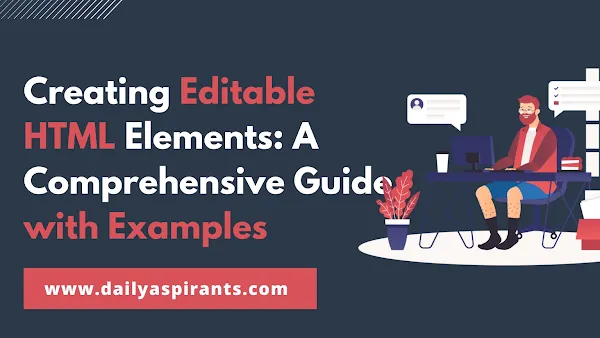The ability to edit content directly within a web page is a powerful feature that enhances user interaction and engagement. In the content make creating editable HTML elements and in the HTML provides a simple attribute called contenteditable that allows you to make various elements editable, enabling users to modify content without needing an external text editor. In this article, we'll explore how to use the contenteditable attribute and provide some examples to demonstrate its usage.
Understanding the contenteditable Attribute
The contenteditable attribute is a straightforward addition to HTML elements that transforms them into editable regions within a webpage. By setting the attribute to "true," you enable users to click on and edit the content within the specified element, directly from their web browser. It's worth noting that the contenteditable attribute is not limited to specific elements; it can be applied to headings, paragraphs, lists, tables, and even entire divisions.
Examples of contenteditable Usage
Editable Paragraph
To make a paragraph editable, you can apply the contenteditable attribute to the <p> element like this:
HTML
<p contenteditable="true">This is an editable paragraph.</p>Editable Heading
Even headings can be made editable. For instance, a heading could be set as editable with the following code:
HTML
<h2 contenteditable="true">Editable Heading</h2>Editable List
Creating an editable list is also straightforward:
HTML
<ul contenteditable="true">
<li>Item 1</li>
<li>Item 2</li>
<li>Item 3</li>
</ul>
Editable Div
If you want to make a more complex structure editable, such as a div containing text and other elements:
HTML
<div contenteditable="true">
<p>Edit this content inside the div.</p>
<ul>
<li>Item 1</li>
<li>Item 2</li>
</ul>
</div>
Editable Table
Even tables can be made editable:
HTML
<table contenteditable="true">
<tr>
<th>Header 1</th>
<th>Header 2</th>
</tr>
<tr>
<td>Cell 1</td>
<td>Cell 2</td>
</tr>
</table>
Best Practices and Considerations
While the contenteditable attribute provides a convenient way to make elements editable, there are some best practices and considerations to keep in mind:
Styling: The default styling of editable elements can vary across different browsers. Ensure that the styling remains consistent and visually appealing across various platforms.
Accessibility: Always consider accessibility when using editable content. Screen readers and other assistive technologies should accurately convey the editable nature of the content to users with disabilities.
User Experience: While contenteditable can improve user interaction, it can also lead to accidental edits. Implement a confirmation mechanism or undo functionality to prevent unintentional content changes.
Validation: If the edited content needs to be saved or processed, use JavaScript to capture the changes and validate the input to prevent malicious or incorrect data from being submitted.
Styling: The default styling of editable elements can vary across different browsers. Ensure that the styling remains consistent and visually appealing across various platforms.
Accessibility: Always consider accessibility when using editable content. Screen readers and other assistive technologies should accurately convey the editable nature of the content to users with disabilities.
User Experience: While contenteditable can improve user interaction, it can also lead to accidental edits. Implement a confirmation mechanism or undo functionality to prevent unintentional content changes.
Validation: If the edited content needs to be saved or processed, use JavaScript to capture the changes and validate the input to prevent malicious or incorrect data from being submitted.
Conclusion
The contenteditable attribute is a valuable tool in web development, enabling users to interact with and modify content directly within a web page. By applying this attribute to various HTML elements, you can create dynamic and engaging user experiences. Remember to consider styling, accessibility, and user experience factors to ensure that editable content enhances your website's functionality without compromising its integrity.
